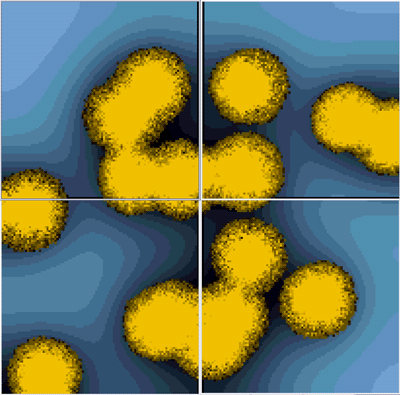However, a challenge of modelling from the individual cellular level up is that it requires significant computational resources in order to scale up to biologically realistic numbers of cells. For example, concentrations of bacterial cells (per millilitre) in nature can range from approximately one million cells in seawater to greater than a billion cells in the human gut. Despite rapid advances in traditional desktop computers, their memory and performance limitations mean it is currently not feasible to model the numbers of agents typically found in the human gut on a single processor. Therefore, it is important to be able to take advantage of parallel high-performance computing resources in order to tackle these problems.
Micro-Gen was designed to take advantage of parallel computing resources, where multiple computers/nodes work together in order to solve a complex problem. In the case of Micro-Gen, the simulated environment in which the bacteria exist is divided equally among the available processors, each of which is responsible for a specific subsection of the population (see Figure 1). Communication between separate processors is handled by the message-passing interface (MPI), which is a common communications protocol used in high-performance computing. For example, when a bacterial cell reaches a border separating parts of the environment controlled by two different processors/ computers, it is sent across to the other computer in a manner analogous to sending a letter between two postal addresses.

Running simulations in tandem across multiple processors/computers overcomes the traditional limitations of the computational resources found in the desktop space. The model can be scaled up according to the number of processors/computers available in order to increase the environment size from the microscopic level up to a visible scale. However, it is important to optimize parallel algorithms so as to avoid the problem of diminishing returns as the number of processors is increased. This problem occurs because with more processors there is more traffic (or 'letters') between them, which can result in significant bottlenecks.
For this reason, particular emphasis has been placed on optimizing the communication strategy for sending bacterial agents between different computer nodes in Micro-Gen, while ensuring the integrity of the information in transit. Advances in communication technology such as the availability of high-speed interconnects ('Infiniband') between the computer nodes and optimized communication strategies have minimized the overheads associated with communication traffic. This has allowed Micro-Gen to be scaled up in testing to 400 processors.
As a consequence, bacterial populations of several billion agents can now be simulated, and important investigations into the population dynamics of large bacterial populations carried out. Questions such as the effect of scale and the interactions between different sub-populations of bacteria can be investigated and correlated with more traditional mathematical modelling approaches that look at the population as a whole. This would allow investigators to trace back from the behaviour of the entire population to that of its individual components. Evolutionary questions could also be asked by incorporating genetic components into the bacterial agents and simulating the competition between genetically differing strains. For further information about the biological aspects of Micro-Gen see ERCIM News, No. 73, p 39-40.
Links:
http://www.computing.dcu.ie/~jamurphy/
http://sci-sym.computing.dcu.ie/
Please contact:
James T. Murphy,
School of Computing,
Dublin City University, Ireland.
Tel: +353 1 700 8449
E-mail: jamurphy![]() computing.dcu.ue
computing.dcu.ue










